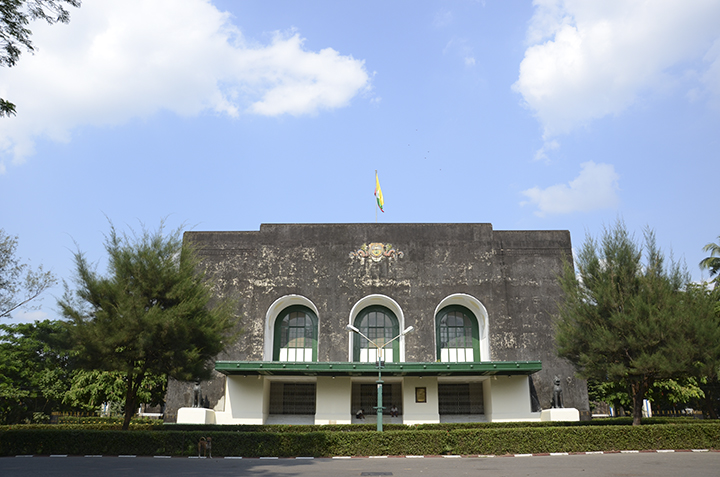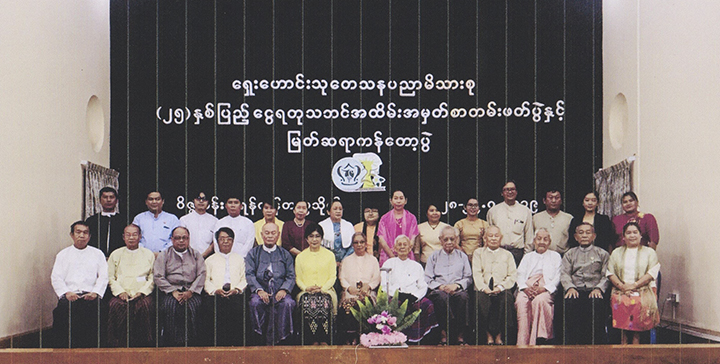By Maha Saddhamma Jotika Dhaja, Sithu
Emeritus Professor
Dr. Khin Maung Nyunt
The Silver Jubilee of the Teaching Department of Archaeology of Yangon University was celebrated at the Arts Hall on the Chancellor Road, University campus on 28th and 29th of July Sunday and Monday 2019 with most fitting programs. Ceremonial opening with Keynote Addresses, opening speeches and remarks, greeting and congratulations by Rector, Professors, and distinguished guests, group photos and coffee break. The following day Monday 29.7.2019 at 2-5 p.m. at the same venue was held Acariya Pujas, Homage paying to the teaching staffs by students old and new with offertories of cash and kind and blessings and appreciations by the teachers. Offering of Swam [ဆွမ်း] lunch to invite monks was held in the morning in memory of the Professors and teachers who had passed away. On Monday 29.7.2019, 2-5 p.m. Dinner was given in the Recreation Centre R.C on the Chancellor Road.
Three paper reading sessions took place on the opening day 28 July 2019 Sunday. After the programmes of opening ceremony and coffee break, three Paper reading Sessions took place. The first section 10.30 a.m. -12 a.m., 4 Papers were read namely —
(1) Potential Approach to Settlement Patterns of Pre-historic Archaeological Sites in Myanmar Thiessen Polygon Analysis by Dr. Kyaw Zeya, Professor of Archaeology teaching Department, Yatanabone University Mandalay.
(2) The Study on the Arrangement and Organization of Buddhist Monastic Complexes in Bagan on archaeological Points of View by Dr. Thin Yu Naing, Assistant Lecture, the teaching Department of Archaeology, Dagon University.
(3) Thara-dipa Aungcha wady) Palace city by Dr. Thein Aung, Professor, Department Head (Rector), Department of History, University of Dawee.
(4) Analysis and estimate of mural paintings on Lu-wun rock boulders by Dr. Maung Maung Lwin, Associate Professor ,Department of Archaeology Yatanabone University.

General Discussion followed.
After Lunch Break Paper Reading session followed 13-14 p.m.
(5) Different Burial Practices of Myanmar [From Pre-historic to Early Historic Period.] By Dr. Zaw Hpyo, Lecturer, the teaching Department of Archaeology, Yatanabone University.
(6) Pre-historic hunter gatherer adaption in Myanmar: Reappraisal on Paleolithic artefacts from central belt by Dr. Tin Htut Aung, Assistant Lecture, the teaching Department of Archaeology, Yangon University , and U Kyaw Win Thu, Associate Professor, Department of Metallurgy, Technical University [Ywama].
(7) Sprit Resettlement Action Plan [SRAP] for Development Projects in Myanmar from the perspective of Intangible Cultural Heritage Management [I C H M], by U Win Naing Htun, Principal consultant and Director, Resource and Environment Myanmar Co, Ltd.
General Discussion
Session 3, 15-16.30 p.m., took place after coffee break.
(8) Study of mural paintings of Bagan 11th Century A.D to late 18th Century A.D 16 dreams of King Kosala by Dr. Aye Aye U, Professor, the teaching Department of Archaeology, University of Dagon.
(9), Archaeological Evidences from Binnaka by Daw Lwin Lwin Kyaw, Lecture, the teaching Department of Archaeology, Yadanabon University,
(10), Study of stone Inscription of Athawa Dhamma Mayar, by Daw Win Yee Hla, Lecture, the teaching Department of Archaeology, Yatanabon University,
(11) Alarm for Myanmar Artworks by Ma Wint Thu Thu Maung, M.A student, the teaching Department of Yangon University.
General Discussion
Paper Reading session as winded up and closed by Dr. U San Shwe, Professor and Head of Department, the teaching Department of Archaeology, University of Yangon.
A brief background of the teaching Department of Archaeology
We have now such departments at Yangon, Dagon, Mandalay and Yatanabon Universities. The writer wishes to clear up the teaching and digging Archaeology Departments.
Archaeology Digging Department was one of the earliest departments opened by the British Colonial Government such as Forest Department, Agriculture Department, and Irrigation Department etc. The Colonial Government wanted to know stone inscription and ink inscription of Myanmar abundantly discovered at old capital cities—
Bagan, Pinya, Taungoo, Amarapura, Shwebo, Mandalay, MraukU, Thaton, Dawei, Bassen etc. became they certain economic and Socio-cultural data on Myanmar history. Myanmar learned Buddhist monks could help only with regard to Pali, Mon, Pyu and Myanmar languages. Sanskrit and other dead languages they can not help. So Dr. C. Forchammer, a medical doctor of Germany serving in Switzerland was chosen by competitive examination and appointed as Super Intendant of the Epigraphic Office, the Burma Branch of Indian Archaeology Survey. The British Colonial Government annexed Myanmar to the British Indian Empire as a province, So the Epigraphic Office of Myanmar was an appendix to it. After Forchamer followed non Burmese Scholars such as Mr. Taw Sein Kho, Charles Douroise G. H Luce and J.S. Furnivall. Only later U Mya, U Lu Pe Win, U Aung Thaw appeared pre and post-World War II.
When the Epigraphic Office (ကျောက်စာဌာန) grew into Archaeology Department, staff and students and new recruits were sent to India, for digging raining. There was no academic teaching of Archeology.
Archaeology is a multidisciplinary subject. Geology, Plentiology, Anthropology, Pre-history etc. are roots of Archaeology. In digging up the past archaeology excavation you need systematic training in excavation. Hence both practical and academic aspects of Archaeology must go hand in hand. But unfortunately it was not so in Myanmar.
Twenty-five years ago today, the writer in the capacity of Director-General of Archaeology Digging Department and U Htun Aung Chain, the then Professor of History, worked together to open the teaching Department of Archaeology at Yangon University with the blessing and approval of the Government. First U Htun Thain introduced archaeology into Hons class and later M.A. The writer began with Diploma class. Later Degree courses were given B.A. B.A. (Hons). M.A. and Ph. D. The writer assigned his colleague U Nyunt Han to teach archaeology. The first Professor was U San Nyein. His successors were Daw Yee Yee Aung of History Department, Mandalay Univesity and current Dr. San Shwe, Prof & Dept head. The writer taught the Diploma Class. When Ph.D programme was introduced, the writer introduces maritime and under water Archaeology which he is still teaching.
Happy coincidences have taken place in current auspicious year 2019. Firstly, Bagan has been admitted into UNESCO’s World culture Heritage Sites and MraukU queuing up for similar admission. The Centenary of Yangon University is to be celebrated in 2020 December and it is now preparing and renovating actives — face lifting, repair, refurnishing. Now the silver Jubilee of the teaching Department of Archaeology most filling celebrated.-GNLM


